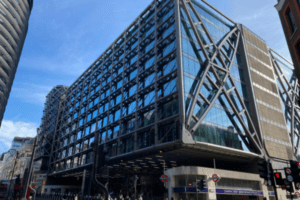v At Tower Green it stands 20 feet tall, with an extra 10 feet added in the medieval period. On top of the Roman wall there was probably a walkway which would have had a crenellated breastwork and been punctuated by turrets. The wall was two miles long, making it by far the longest city wall in the province of Britannia, and it would have had at least four gateways – what are now known as Aldgate, Bishopsgate, Newgate and Ludgate – and maybe Cripplegate and Aldersgate as well.
It was finished around 215 AD and would have taken around 30 years to build. The dating is based partly on numismatic evidence. This includes a hoard of coins and clay moulds for coins found within what was probably a stairwell of an internal tower on the site of the Central Criminal Court. The coins included one in almost mint condition issued in the reign of Caracalla (212 to 217 AD). A coin mould in the hoard had an image of Severus (201 to 210 AD) on its obverse, and another Geta (2110-211 AD). Caracalla and Geta were the sons of Severus. The reason Geta’s reign was so short was because he was probably murdered by Caracalla.
Before this time only a few urban settlements in Britain had walls. This was partly due to the reluctance of emperors to sanction fortifications which were not under the direct control of their armies. You needed the emperor’s permission to build a wall.
Then in the late second century there was something of a flurry of wall construction, including at Verulamium and Cirencester. It would make military sense to have a wall as in order to take a defended city you needed planning, time and siege-engines. Rebel tribes in the empire lacked these.
There is some evidence of a major disturbance in the province about the time of the accession of Commodus in 180 AD ie just before the putative start date of the wall. The historian Dio refers to enemy tribes crossing Hadrian’s Wall, ravaging widely and killing a general and the troops he had with him. The ‘general’ may well have been the governor of the province, implying a very serious reverse for the administration. The walls at London and elsewhere might have been a response to this threat.
However, one problem with this theory is that the wall did not extend along the riverside – it was incomplete. Furthermore, later in the third century they obviously did feel the need to defend this southern stretch of the city as this large gap in the defences was filled in, in the 250s to 270s AD.
This wall was built quickly. It is built roughly, without the care shown earlier, and contained numerous re-used stones, including material from what was probably a triumphal arch made for when the Emperor Hadrian visited the city. The builders were clearly using stone wherever they could find it close to hand. The earlier wall was built of ragstone, which had to be imported from Kent. At the time of the riverside wall’s construction London was threatened by Saxon raiders.
The other possible motivations for building the wall were as an assertion of urban status, and as a means of controlling those entering and leaving the city. Other towns had walls. For example, Colchester had one from the first century, and it may well be that Londinium felt it needed one too to reflect its status as what was probably the capital of the province.
These reasons are not mutually exclusive. The long time it took to build the wall does not mean it was not a response to a perceived threat, simply a long-term response, and one influenced by the desire to have impressive and well-built walls. The river may have been left without defences because of the need for the port to function. There is some evidence of the wharves later falling into disuse before the riverside wall was built, either as a result of external threat or a decline in the port’s trade. There is a suggestion of the port’s activities shifting downriver to what is now Wapping. It may have been felt before this that the extra security provided by defence along the river was not worth the price of making the port unusable.
–
Find out more about the Roman London Wall, its history, and Londinium in general. Book tickets for Ian McDiarmid’s Roman London Walk now. Private tour also available here.
Also listen to our London History Podcast Episode 1: Roman London – An Introduction.


